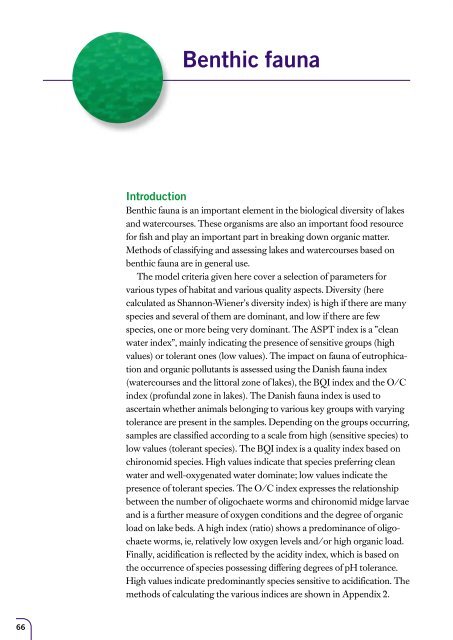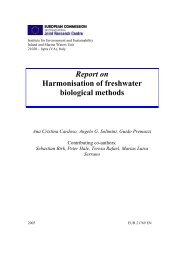Lakes and Watercourses
Lakes and Watercourses
Lakes and Watercourses
Create successful ePaper yourself
Turn your PDF publications into a flip-book with our unique Google optimized e-Paper software.
Benthic fauna<br />
Introduction<br />
Benthic fauna is an important element in the biological diversity of lakes<br />
<strong>and</strong> watercourses. These organisms are also an important food resource<br />
for fish <strong>and</strong> play an important part in breaking down organic matter.<br />
Methods of classifying <strong>and</strong> assessing lakes <strong>and</strong> watercourses based on<br />
benthic fauna are in general use.<br />
The model criteria given here cover a selection of parameters for<br />
various types of habitat <strong>and</strong> various quality aspects. Diversity (here<br />
calculated as Shannon-Wiener’s diversity index) is high if there are many<br />
species <strong>and</strong> several of them are dominant, <strong>and</strong> low if there are few<br />
species, one or more being very dominant. The ASPT index is a ”clean<br />
water index”, mainly indicating the presence of sensitive groups (high<br />
values) or tolerant ones (low values). The impact on fauna of eutrophication<br />
<strong>and</strong> organic pollutants is assessed using the Danish fauna index<br />
(watercourses <strong>and</strong> the littoral zone of lakes), the BQI index <strong>and</strong> the O/C<br />
index (profundal zone in lakes). The Danish fauna index is used to<br />
ascertain whether animals belonging to various key groups with varying<br />
tolerance are present in the samples. Depending on the groups occurring,<br />
samples are classified according to a scale from high (sensitive species) to<br />
low values (tolerant species). The BQI index is a quality index based on<br />
chironomid species. High values indicate that species preferring clean<br />
water <strong>and</strong> well-oxygenated water dominate; low values indicate the<br />
presence of tolerant species. The O/C index expresses the relationship<br />
between the number of oligochaete worms <strong>and</strong> chironomid midge larvae<br />
<strong>and</strong> is a further measure of oxygen conditions <strong>and</strong> the degree of organic<br />
load on lake beds. A high index (ratio) shows a predominance of oligochaete<br />
worms, ie, relatively low oxygen levels <strong>and</strong>/or high organic load.<br />
Finally, acidification is reflected by the acidity index, which is based on<br />
the occurrence of species possessing differing degrees of pH tolerance.<br />
High values indicate predominantly species sensitive to acidification. The<br />
methods of calculating the various indices are shown in Appendix 2.<br />
66















![Accommodation booking form [PDF]](https://img.yumpu.com/39471785/1/184x260/accommodation-booking-form-pdf.jpg?quality=85)

